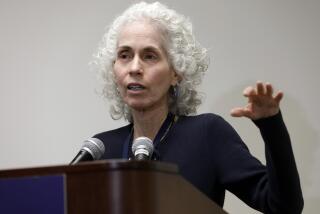Hospital Hopes Change of Address Will Give Image Shot in Arm
- Share via
LONG BEACH — The name change was nearly impossible to miss. When Dominguez Valley Hospital became Dominguez Medical Center in August, thousands of drivers streaming through Compton on the Artesia Freeway could see workers bolting a new sign atop the four-story structure.
A more discrete alteration, however, was made to the hospital’s stationery--a change that officials say was just as necessary to keep the 250-bed facility prosperous, even at the risk of alienating some of the people it serves.
After 23 years, the Dominguez mailing address was moved from one side of the hospital to the other so it would lie in Long Beach instead of Compton.
“Compton has a negative image as a city,” Dominguez Administrator Lorraine P. Auerbach, 35, explained in an interview this week. “Basically, that’s what we’re looking to get away from.”
Easy Way
She quickly cautioned that “I just want to be a little careful with that. I don’t want to turn off my local community . . . They recognize it, they’re trying to work to upgrade the community, they’re attracting a lot of new businesses. And I just don’t want to get out there knocking what they’re trying to do because I’ve had an easy way to do something different.”
But Auerbach--who was installed as the hospital’s chief executive 10 months ago by Westwood-based National Medical Enterprises Inc., one of the nation’s leading for-profit health-care chains--said she had to do that something different.
In this era of high-pressure medical competition, she said, a hospital’s fragile identity can be all that stands between success or failure. An address in Long Beach rather than Compton, she said, could help Dominquez attract patients from beyond its immediate geographical area.
“We’re in the most competitive service area in, probably, the United States,” Auerbach said. “The greater Long Beach area is on the leading edge probably of competition, of changes in health care, of HMO (health maintenance organization) penetration . . . You normally don’t see 22 very active hospitals that you’re competing with for the same population. And it’s a no-growth or a minimal growth area. So that’s why competition is just bubbling up to the surface as the priority of the day.”
Aggressive Advertising
And that’s why Dominguez is using every method it can to “differentiate” itself from the rest of the medical pack, Auerbach said. Over the next few months, she said, the hospital--already fairly profitable with $55-million in annual revenue--will engage in a more aggressive advertising and marketing campaign to improve its image and broaden its patient base.
Dominguez has already repainted its interior with comfortable pastels, invested in hundreds of thousands of dollars worth of new medical equipment and begun to remold the attitudes of its 700 full- and part-time employees, of which 180 are staff physicians, Auerbach said.
“I don’t think they really went out of their way to provide service and really communicate effectively with the patients,” the administrator said of the Dominguez staff she first encountered. “It wasn’t an overt orientation to service and guest relations. It was OK, no one was really negative. But no one really went out of their way to be positive either.”
Good Attitude
A good employee attitude is especially important at a mid-sized community hospital like Dominguez, where a recent survey found that nearly half the people in its service area didn’t even know that the facility existed. “Basically, we were just on a corner in the north end of Long Beach and off the freeway,” Auerbach said, “and no one really knew who we were and what kinds of service we provided. We were just, you know, nothing special.”
Dominguez, of course, is not the only area hospital fighting to market itself as something special in the minds of potential patients.
At 11 a.m. today, for example, St. Mary Medical Center in downtown Long Beach will dedicate a $27-million “medical mall,” a walled-in complex of professional and commercial office space designed to someday serve as a one-stop health-care shopping center offering everything from brain surgery to bran flakes. “We’re trying to make what’s available more convenient,” said Michael E. Markley, St. Mary associate administrator and vice president. Surveys, he said, show that convenience matters a great deal to patients.
Important Factors
A July 1983 study conducted at Dominguez also underscores how much hospitals these days need to pay attention to non-medical factors--about 53% of the people survey said the friendliness of a hospital’s staff and its geographical convenience were the most important factors in selecting one facility over another. Only 11% said they were more concerned with a hospital’s medical quality.
“The general public doesn’t really understand how to measure (hospital) quality, “ said Auerbach. “They measure more of the hotel services that a facility provides than the medical services . . . They equate quality to hot food and clean environment and positive rapport in relationship with the people that they meet in the hospital.”
So Dominguez wants the community to know it is taking new steps to respond, Auerbach said. For example, new food-warming carts have been purchased to solve a long-standing patient complaint that dinners are cold by the time they reach the hospital’s wards.
And the staff members who deliver meals to patients will be sharpening their bed-side manners.
“If you went to a fine restaurant with the best food in the world and the waiter was obnoxious you probably wouldn’t go back,” said Auerbach. “So it’s the balance of professionalism and a positive approach that I think makes a person feel more comfortable.”
More to Read
Inside the business of entertainment
The Wide Shot brings you news, analysis and insights on everything from streaming wars to production — and what it all means for the future.
You may occasionally receive promotional content from the Los Angeles Times.











